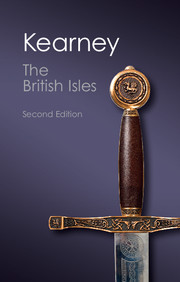Book contents
- Frontmatter
- Contents
- List of illustrations
- List of maps
- Preface to the first edition
- Preface to the second edition
- Map: the British Isles
- Introduction
- 1 The Celtic societies of the British Isles
- 2 The impact of Rome on the British Isles
- 3 The post-Roman centuries
- 4 The Vikings and the fall of the Old Order
- 5 The Norman and post-Norman ascendancy
- 6 The decline of the post-Norman empire
- 7 The making of an English empire
- 8 The remaking of an empire
- 9 The Britannic melting pot
- 10 The rise of ethnic politics
- 11 Between the wars
- 12 Withdrawal from empire
- 13 Post-imperial Britain: post-nationalist Ireland
- Afterword
- Selected reading list
- Index
3 - The post-Roman centuries
Published online by Cambridge University Press: 05 June 2014
- Frontmatter
- Contents
- List of illustrations
- List of maps
- Preface to the first edition
- Preface to the second edition
- Map: the British Isles
- Introduction
- 1 The Celtic societies of the British Isles
- 2 The impact of Rome on the British Isles
- 3 The post-Roman centuries
- 4 The Vikings and the fall of the Old Order
- 5 The Norman and post-Norman ascendancy
- 6 The decline of the post-Norman empire
- 7 The making of an English empire
- 8 The remaking of an empire
- 9 The Britannic melting pot
- 10 The rise of ethnic politics
- 11 Between the wars
- 12 Withdrawal from empire
- 13 Post-imperial Britain: post-nationalist Ireland
- Afterword
- Selected reading list
- Index
Summary
Within the British Isles the period between the departure of the Romans (c. 400) and the coming of the Vikings (c. 800) was marked by the interaction of four distinct cultures, British, Pictish, Irish and Anglo-Saxon. At the beginning of the period British culture (the culture of the P-Celtic-speaking peoples) was dominant over most of the island of Britain south of the Forth. Much of this culture in what is now southern England and South Wales was heavily Romanised. Roman towns and general organisation survived well into the fifth century. Further north, for example in the territory of the Votadini between the Forth and the Tweed, the extent of Roman influence had been much less. North of the Forth, the culture of the Picts (originally known to the Romans first as Caledonii and then from the fourth century as Picti) was dominant. We know less about the Picts than any of the other three major cultures of the British Isles but place-names and other evidence indicate that there were two main groups, the southern Picts south of the Mounth and northern Picts north of the Mounth and in Shetland and Orkney. During the Roman centuries the Q-Celtic-speaking cultures of Ireland had been placed in a position of relative isolation, which was being broken down by the arrival of Christian missionaries from Britain and the continent.
- Type
- Chapter
- Information
- The British IslesA History of Four Nations, pp. 41 - 59Publisher: Cambridge University PressPrint publication year: 2012



